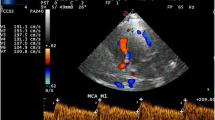Abstract
Cerebral arteriopathy can be detected in children with sickle cell disease (SCD) by transcranial Doppler (TCD). Abnormally high velocities are predictive of high stroke risk, which can be reduced by transfusion therapy. We report the results of the screening of 291 SCD children followed in our center, including the clinical and imaging follow-up of 35 children with abnormal TCDs who were placed on transfusion therapy. We postulated that patients with normal MRA findings and abnormal TCD velocities that normalized on a transfusion program could be safely treated with hydroxyurea (HU). We report their outcome (median follow-up of 4.4 years). Of 13 patients with normalized velocities on transfusion, 10 had normal MRAs, and transfusion therapy was stopped and HU begun. Four of these ten patients redeveloped high velocities off transfusion, so currently only six remain transfusion-free. Six other transplanted patients remain transfusion-free. Abnormal TCD velocities detect a high-risk group, justifying the research for suitable transplant donors. Multicenter studies comparing HU therapy to long-term transfusion might help identify which patients can avoid transfusion and its complications while avoiding vasculopathy.




Similar content being viewed by others
References
Adams RJ, McKie V, Nichols F, et al (1992) The use of transcranial ultrasonography to predict stroke in sickle cell disease. N Engl J Med 326:605–610
Adams RJ, Nichols T, Ramon F, et al (1992) Transcranial Doppler correlation with cerebral angiography in sickle cell disease. Stroke 23:1073–1077
Verlhac S, Bernaudin F, Tortrat D, et al (1995) Detection of cerebrovascular disease in sickle cell disease children by transcranial Doppler sonography. Correlation with MRI and MRA and conventional angiography. Pediatr Radiol 25:S14–S19
Bernaudin F, Verlhac F, Fréard F, et al (2000) Multicenter prospective study of children with sickle cell disease: radiographic and psychometric correlation. J Child Neurol 15:333–343
Verlhac S, Bernaudin F, Brugieres P (2003) Transcranial color Doppler in children with sickle cell disease (in French). J Radiol 84:131–138
Adams RJ, McKie VC, Carl EM, et al (1997) Long-term stroke risk in children with sickle cell disease screened with transcranial Doppler. Ann Neurol 42:699–704
Adams RJ, McKie VC, Hsu L, et al (1998) Prevention of a first stroke by transfusions in children with sickle cell anemia and abnormal results on transcranial Doppler ultrasonography. N Engl J Med 339:5–11
Bernaudin F, Lesprit E, Akou’ou MH, et al (2001) Single centre experience of long-term use of hydroxyurea-therapy for pediatric SCD patients: interest of HU for patients with severe anemia. National Sickle Cell Disease Program, New York (abstract)
Russell MO, Goldberg HI, Hodson A, et al (1984) Effect of transfusion therapy on arteriographic abnormalities and on recurrence of stroke in sickle cell disease. Blood 63:162–169
Charache S, Terrin ML, Moore RD, et al (1995) Effect of hydroxyurea on the frequency of painful crisis in sickle cell anemia. N Engl J Med 332:1317–1322
De Montalembert M, Belloy M, Bernaudin F, et al (1997) Three-year follow-up of hydroxyurea treatment in severely ill children with sickle cell disease. The French Study Group on Sickle Cell Disease. J Pediatr Hematol Oncol 19:313–318
Vichinsky EP, Lubin BH (1994) A cautionary note regarding hydroxyurea in sickle cell disease. Blood 83:1124–1128
Ware RE, Zimmerman SA, Schultz WH (1999) Hydroxyurea as an alternative to blood transfusions for the prevention of recurrent stroke in children with sickle cell disease. Blood 94:3022–3026
Bernaudin F, Verlhac S, Brugieres P, et al (2001) Early cerebral exploration with transcranial Doppler (TCD) in patients with sickle cell disease (SCD): effects of age and risk factors on velocities. Blood 98:S:3261:84a
Bernaudin F, Souillet G, Vannier JP, et al (1997) Sickle cell disease and BMT: report of the French experience concerning 26 children transplanted for severe SCD. Bone Marrow Transplant 19(S2):112–115
Bernaudin F, Vernant JP, Vilmer E, et al (2002) G for the SFGM-TC. Results of myeloablative allogenic stem cell transplant (SCT) for severe sickle cell disease in France. Blood 100: 11(abstract 4 P5a)
Author information
Authors and Affiliations
Corresponding authors
Rights and permissions
About this article
Cite this article
Bernaudin, F., Verlhac, S., Coïc, L. et al. Long-term follow-up of pediatric sickle cell disease patients with abnormal high velocities on transcranial Doppler. Pediatr Radiol 35, 242–248 (2005). https://doi.org/10.1007/s00247-005-1419-5
Received:
Accepted:
Published:
Issue Date:
DOI: https://doi.org/10.1007/s00247-005-1419-5




